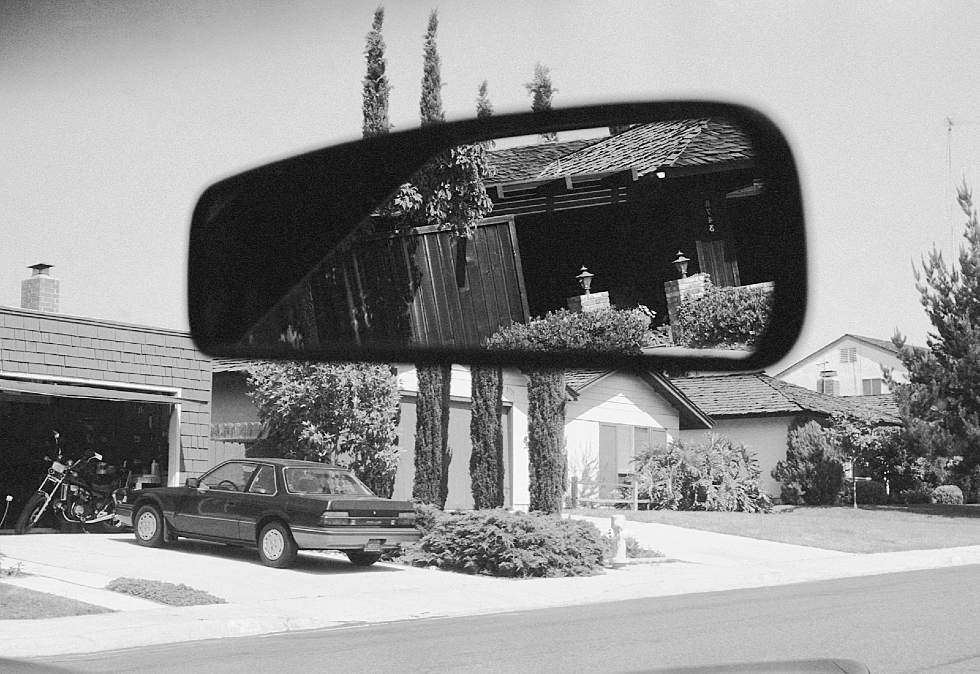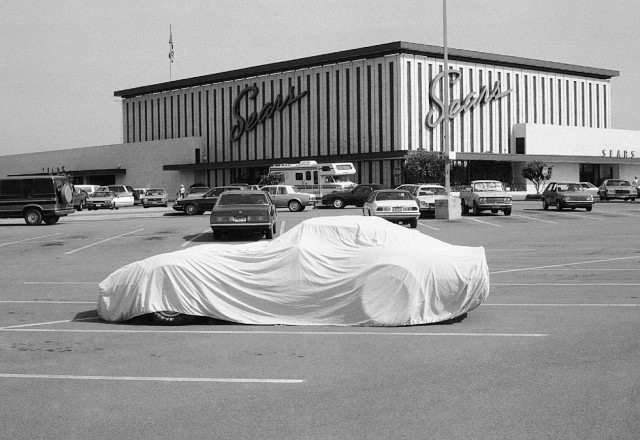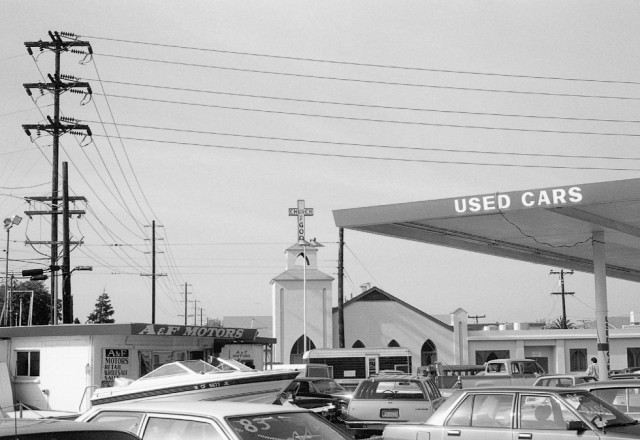Over My Shoulder – Hollywood and the Photographs of Stephen Clarke

A new exhibition of photographs by Stephen Clarke reveals Hollywood’s lingering afterimage on all our psyches, says Mike Pinnington…
A nerve-wracking encounter that sometimes gets forgotten owing to the early crescendo of the shower scene in Alfred Hitchcock’s Psycho (1960) comes long before we meet Norman and his mother at the imposing Bates Motel. From the moment Janet Leigh’s real estate secretary, Marion Crane, flees town, having opted to steal rather than bank $40,000 of the firm’s money from a property sale, she is looking anxiously over her shoulder. The stolen haul – stowed in a hastily packed suitcase – weighs heavy, burning a hole in her mind. Leaving behind the claustrophobia of the city, having driven through the night, there is fresh dread – a manifestation of the madness and desperation that led her here – when a cop knocks on her window as she sleeps in her car on the roadside.
Looming menacingly large and implacable, intent unreadable behind big, dark aviator shades, his is a presence of studied ambivalence. Tensions – and viewer heart rates – rise as the officer requests Marion’s driver’s license and checks her plates. “He knows, he knows,” she thinks to herself, trying to keep it together; even as Marion is eventually free to drive on, leaving the cop in her wake, she continues to nervously check her rear-view mirror until he takes a turn off. Although this isn’t the last she will see of the cop (suspicious of her skittishness, he later trails her into town), there is, of course, much worse than the long arm of the law to come for Marion. But, for now at least, she is on her way.
Her onward journey includes many signifiers that situate us in mid-twentieth century America – towering telegraph poles; sun-scorched, barely inhabited brushland and a patchwork of largely barren hills in an arid landscape; large, flat expanses, the open road, used car lots. In one of these, the increasingly frantic Marion trades in her car for another, one with California plates. Belated confirmation, if we were in any doubt, that this is unmistakably the visual language of Hollywood. It’s a language that, consciously or otherwise, we are all familiar with and susceptible to.
The artist Cindy Sherman leant heavily on such suppositions with her brilliantly inventive Untitled Film Stills (1977-1980). The series of black-and-white photographs, rich with narrative suggestion, play with and evoke 1950s and 60s female stereotypes, as perpetuated by Hollywood: naïf, city girl, icy blonde, and lonely housewife. Many of them bear a remarkable resemblance to Hitchcockian templates and could easily pass for Marion Crane’s kleptomaniac woman on the run.
“Photography is truth. The cinema is truth twenty-four times per second,” said French New Wave auteur (and Hitchcock admirer) Jean-Luc Godard. But whose truth are we seeing, exactly? And aren’t those twenty-four frames simply twenty-four opportunities to tell a mediated, more seductive version of events? The director’s preferred reading? So much so has Hollywood shorthand insinuated itself into our lives and psyches that we each now hold in our mind’s eye many working simulacrum of its landscapes, its actors; the setup, the confrontation and the resolution. For a century now, Hollywood has worked its magic so effectively that – whether we’ve seen it with our own eyes or not – we can all picture, and think we know, its highways and byways.
Stephen Clarke’s San Diego photographs invoke such readings, ones that – such is America’s pop culture hegemony – are part of a larger Western consciousness. A young graduate from Lancashire in the 1980s, he spent a year in southern California trying to work out life’s next steps. There, staying in an unglamorous apartment complex, he worked a number of low-income McJobs, hung out with local rock bands and occasionally crossed the border into Tijuana, Mexico. His downtime, though, was spent mainly shooting photographs; they were made entirely without artifice and, yet, are nevertheless ripe for projected narratives.

Like the America that has been relentlessly sold to us down the years, they practically buzz with possibility: untamed edge lands tinged with danger, excitement, risk, and escape. In them we can see the suggestions of David Lynch’s picket fences (behind which darkness inevitably lurks), the remote, sparsely inhabited beachside community of Clint Eastwood’s Play Misty for Me (1971), and the SoCal/Mexico border crossed by unwitting guys out for a good time in Ida Lupino’s The Hitch-Hiker (1953). Clarke’s photographs, however unintentionally, unavoidably frame San Diego as a film set, one containing memories of movies past and suggestions of those never and yet to be made.
In these pictures we can easily plot potential action. In one (above), a fast-looking car (a Corvette Stingray?) stands out like a sore thumb in a Sears car park. The only covered vehicle – ostensibly from the sun’s rays but also, no doubt, from prying eyes – it awaits a getaway driver in an as yet unwritten heist movie. Elsewhere, a meet-cute for soon-to-be young lovers occurs at a cheap Mexican food joint in a strip mall, when the waitress accidentally-on-purpose spills the contents of a taco in a boy’s lap. In another, a helicopter flies low overhead. Taking in the flat San Diego topography, which stretches out as far as the eye can see, it carries a journalist hot on the heels of a story involving a bank job gone horribly wrong.

All of these stories and more can be found in Clarke’s San Diego photographs. Cultural recall abounds – could that be the actual real estate office where Marion Crane once worked? And, surely, that’s the used car lot she would later pay over the odds for a ride with clean plates? Imagine for a moment Marion hadn’t been forced to stop late at night by the driving rain at the Bates Motel (therefore avoiding Norman’s nefarious attentions). Imagine instead that she’d made it all the way to her divorcé lover Sam Loomis’ house (for whom she’d risked everything to steal that $40,000). In the first photograph that accompanies this essay, let’s say a woman, we’ll call her Marion, habitually peers into her rear-view mirror, knowing that at any minute she could be forced to decide whether to floor it or reach for the sky.
Waiting patiently, but hopelessly frazzled by a dirty cocktail of nights on the road, adrenalin, and fear, she looks again and again into that rear-view mirror. Through it, she stares intently, waiting for Sam to re-emerge with his passport, and a bag containing only the bare essentials. All the while she’s conscious of curtains twitching in the neighbourhood, and the shades-wearing cop who has doggedly trailed her ever since that early fitful sleep on the freeway; even now, many miles down the line, he is surely closing in. She is a fugitive, and this is her life. She’s not gonna stop now… Make your own guess at what comes next; you have the pictures with which to do it.
Mike Pinnington
All images © Stephen Clarke
Alien Resident: San Diego Photographs 1986-1987 was due to open at Contemporary Art Space Chester. Check the gallery’s website for updates
Further Reading: Truth and Memory: Stephen Clarke – San Diego Topographics





